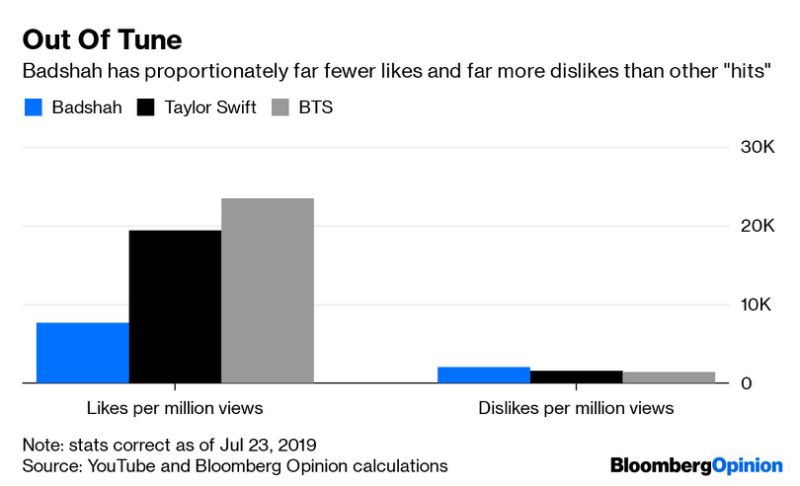

(Bloomberg Opinion) — Imagine you’re a moderately successful Indian rapper eager to graduate to global superstardom. You’ve had a few domestic number-one hits and performed on a handful of Bollywood soundtracks, but the likes of South Korea’s BTS and Psy – other artists who don’t primarily sing in English – have something you don’t: a viral YouTube smash that breaks some sort of record. Most views in a day, for instance.
Going viral can seem a tall order, but not as tall as you’d think, given some of YouTube’s peculiarities. Especially if your name is Badshah. Sony Music India declared in a press release last week that the rapper’s new video, Paagal, had overtaken BTS’s “Boy With Luv” and Taylor Swift’s “Me!” to become YouTube’s most-watched video in a 24-hour period, with 75 million views.
That’s quite some company for an artist without much of a profile outside of his home market. It prompted accusations from social media users that Badshah had somehow gamed the system. And there are weaknesses in Google’s advertising setup that might have made that possible. If anyone can exploit them, this poses a conundrum to Alphabet Inc., the parent company of both Google and YouTube.
One major discrepancy with the other superstars lies in Badshah’s engagement numbers. Taylor Swift and BTS have significantly more likes as a proportion of total views than Badshah does, and considerably fewer dislikes. They’re simply punching in different leagues. It suggests that people aren’t watching the videos in quite the same way.
What’s more, YouTube is yet to issue a press release confirming the viewership record, as it has in the other cases. Just last week it teamed up with Vivendi SA’s Universal Music Group to announce that Queen’s “Bohemian Rhapsody” had totted up more than a billion views.
Also: Paagal just ain’t that good a tune. It entered the U.K.’s Asian Music Chart at a mediocre number 31.
But the biggest clue comes from Badshah himself. In response to online complaints that he deployed bots to boost views, the singer offered a more straightforward answer in an Instagram post: he used Google’s own advertising platform to promote the video, which is a puzzling mix of L.A. skylines and scantily clad dancers cutting shapes in a warehouse.
He didn’t specify which of Google’s bevy of ad products he used. But his response hints at a way that artists (and their labels) can exploit YouTube to their advantage: the public view count doesn’t differentiate between views generated by paying to be a pre-roll advertisement on other clips, or organic views that people have found by other means. The approach would circumvent the need for a bot farm repeatedly to check out the song. Google has some safety nets to make it harder for bots to tot up visits anyway.
Buying pre-roll publicity is also easier in India, where ad impressions are a lot cheaper than other corners of the world, including the U.S. It’s not clear how many of those translate into actual views – Google doesn’t reveal the time threshold for one to count (whether it’s five, 10 or 30 seconds, for instance). Even so, it wouldn’t be all that expensive for Badshah or his peers to reach a significant audience.
For some 5 million rupees ($72,526), you could theoretically generate almost 67 million video ad impressions in India, Claudia Ziegenbein, head of paid search at Mediacom U.K., estimates. That’s significantly cheaper than getting in front of a similarly sized audience in the U.S. or U.K., she said. A spend of around $1.5 million could well be required to hit 60 million impressions there.
Does this shine a particularly bad light on Badshah and Sony Corp.’s Indian music arm? Not really. The system exists, and if they used it, they did so successfully and to their advantage. They wouldn’t be the first in the history of recorded music, or indeed of YouTube promotion. And once the view count hit a sizable level, the organic audience would start to pick up too. Sony Music India has 27 million followers of its own, but most of its videos have far fewer than one million views.
Instead, it looks like this is another lesson that the best way to generate engagement on social media is to pay for it. The platforms hold all the keys.
YouTube itself is in a pickle. It can’t be seen to condone any gaming of its ads platform to generate a hit. But it also won’t want to dissuade advertisers from paying for viewership. That’s literally what pays the bills. Next best solution? Just keep quiet and hope it all blows over.
To contact the author of this story: Alex Webb at [email protected]
To contact the editor responsible for this story: Jennifer Ryan at [email protected]
This column does not necessarily reflect the opinion of the editorial board or Bloomberg LP and its owners.
Alex Webb is a Bloomberg Opinion columnist covering Europe’s technology, media and communications industries. He previously covered Apple and other technology companies for Bloomberg News in San Francisco.
<p class="canvas-atom canvas-text Mb(1.0em) Mb(0)–sm Mt(0.8em)–sm" type="text" content="For more articles like this, please visit us at bloomberg.com/opinion” data-reactid=”43″>For more articles like this, please visit us at bloomberg.com/opinion
©2019 Bloomberg L.P.




